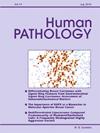NPM1在皮肤母细胞浆细胞样树突状细胞肿瘤中突变频率的研究
IF 2.7
2区 医学
Q2 PATHOLOGY
引用次数: 0
摘要
母细胞浆细胞样树突状细胞肿瘤(BPDCN)和急性髓系白血病(AML)表现出重叠的临床病理表现,这使得在小皮肤活检上进行区分具有挑战性。NPM1突变是AML中最常见的遗传病变,占病例的三分之一,并导致NPM1突变体的异常细胞质脱位,这可以通过免疫组织化学染色检测到。BPDCN中NPM1突变的频率仍然存在争议。我们的目的是研究皮肤BPDCN病例中的NPM1突变,并将其与皮肤NPM1阳性的白血病皮肤病例进行比较。方法通过多机构检索,我们发现并分析了13例皮肤BPDCN和19例皮肤髓系肉瘤(其中7例为原发性白血病皮肤)的NPM1突变。我们比较了这些患者的临床和病理表现,并确定了这些组之间的显著特征。结果与皮肤髓系肉瘤患者相比,bpdcn患者年龄较大,白细胞计数较低,血红蛋白水平较高,血小板计数升高(p <;0.05)。两组患者在诊断时骨髓受累情况相似,受累率无显著差异;然而,参与的百分比在两组之间有显著差异。复杂核型在BPDCN患者中更为常见(37.5%),而在皮肤髓系肉瘤患者中为15.7% (p <;0.05)。突变谱在两组BPDCN病例中存在差异,没有NPM1突变。比较两组共突变发现,BPDCN病例中IDH2、NRAS和SRSF2突变显著富集。结论:我们发现BPDCN患者与皮肤AML患者存在相似的方式,但似乎一致缺乏NPM1突变。我们的研究表明,NPM1可以作为一种替代免疫组织化学染色剂,以一种快速和经济的方法将这种罕见疾病与髓系肉瘤区分开来。本文章由计算机程序翻译,如有差异,请以英文原文为准。
Investigation of NPM1 mutation frequency in cutaneous blastic plasmacytoid dendritic cell neoplasms
Background
Blastic plasmacytoid dendritic cell neoplasm (BPDCN) and acute myeloid leukemia (AML) show overlapping clinicopathological presentations, which makes it challenging to differentiate on a small skin biopsy. NPM1 mutations are the most common genetic lesions in AML, accounting for one third of cases and cause an aberrant cytoplasmic delocalization of NPM1 mutants, which can be detected by an immunohistochemical stain. Frequency of NPM1 mutations in BPDCN remains controversial. We aimed to investigate NPM1 mutations in cutaneous BPDCN cases and compare them with cutaneous NPM1 positive leukemia cutis cases.
Methods
From a multi-institutional search, we identified and analyzed 13 cases of cutaneous BPDCN and 19 cases of cutaneous myeloid sarcoma (7 of which were primary leukemia cutis) with NPM1 mutations. We compared the clinical and pathological findings of these patients and identified distinguishing features between these groups.
Results
BPDCN patients presented at an older age, with lower white blood cell count, higher hemoglobin level, and elevated platelets counts as compared to cutaneous myeloid sarcoma patients (p < 0.05). The bone marrow of patients in both groups was similarly involved at the time of diagnosis with no significant difference in rate; however, the percentage of involvement was significantly different among the two groups. Complex karyotype was more frequently seen in BPDCN patients (37.5 %) as compared with 15.7 % of cutaneous myeloid sarcoma patients (p < 0.05). Mutational profile differed among the two groups with absence of NPM1 mutations in BPDCN cases. Comparison of co-mutations detected in both groups revealed that BPDCN cases were significantly enriched in IDH2, NRAS, and SRSF2 mutations.
Conclusion
We find that BPDCN patients present in a similar way to cutaneous AML patients but appear to uniformly lack NPM1 mutations. Our study suggests that NPM1 can be used as a surrogate immunohistochemical stain to differentiate this rare disease from myeloid sarcoma in a rapid and cost-effective method.
求助全文
通过发布文献求助,成功后即可免费获取论文全文。
去求助
来源期刊

Human pathology
医学-病理学
CiteScore
5.30
自引率
6.10%
发文量
206
审稿时长
21 days
期刊介绍:
Human Pathology is designed to bring information of clinicopathologic significance to human disease to the laboratory and clinical physician. It presents information drawn from morphologic and clinical laboratory studies with direct relevance to the understanding of human diseases. Papers published concern morphologic and clinicopathologic observations, reviews of diseases, analyses of problems in pathology, significant collections of case material and advances in concepts or techniques of value in the analysis and diagnosis of disease. Theoretical and experimental pathology and molecular biology pertinent to human disease are included. This critical journal is well illustrated with exceptional reproductions of photomicrographs and microscopic anatomy.
 求助内容:
求助内容: 应助结果提醒方式:
应助结果提醒方式:


